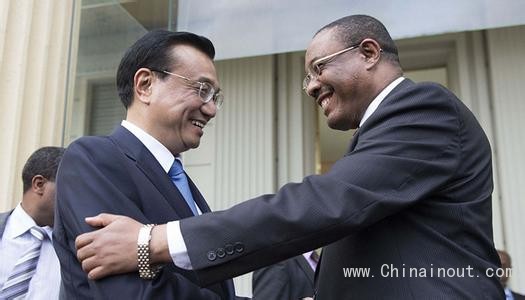
一些經濟學家認為,非洲大陸在基礎設施領域存在巨大投資需求,是非洲經濟騰飛的一個重要條件。法國前外長韋德里納和另一位經濟學家利昂內爾·津蘇為法國經濟部起草的一份報告顯示,未來幾年間,非洲地區在這個領域的投資需求將達到1180億美元。非洲開發銀行行長唐納德·卡貝魯卡認為,基礎設施建設已成為非洲發展的標志。在過去10年,非洲開發銀行出資280億美元用于非洲的基礎設施建設。
其次,非洲大陸貿易自由化進程正在向前推進,未來有望大大提升非洲國家間貿易水平。今年6月10日,整合東南非共同市場、南部非洲發展共同體和東非共同體的三方自由貿易協議成功簽署,該自貿區覆蓋26個國家,涉及6.25億人口,相關國家國內生產總值總額達到1.2萬億美元,占整個非洲生產總值的58%。5天后,非洲聯盟成員國啟動了非洲大陸自由貿易協議談判,旨在于2017年建立一個覆蓋全部非洲人口、經濟總量達到2萬億美元的超級自貿區。
此外,人口紅利將逐漸釋放,也是看好非洲經濟遠景的重要因素。非洲開發銀行公布的數字顯示,非洲的人口到2050年將增加一倍,總數將達20億,屆時那些擁有一定支付能力的中產階級人口將超過14億。
當然,讓美好的憧憬變成現實,非洲還要經受巨大考驗。畢竟,目前約6 億非洲人(相當于非洲總人口的2/3)仍用不上電;60%的城鎮居民生活在貧民窟當中;36%的人喝不上合格的自來水。雖然擁有豐富的土地和水資源,但非洲糧食產量偏低,2013年非洲83%的糧食依靠進口,面臨嚴重的糧食危機。
正如法國《論壇報》網站曾刊登阿爾弗雷德·米尼奧的一篇文章講述的那樣,今天的非洲就好像是一只裝了一半水的瓶子:在“非洲悲觀主義者”看來,還是一個空瓶子;在“非洲樂觀主義者”眼里,卻是一個充滿了各種實際機遇的瓶子。從目前來看,全球主要國家的政策制定者都加入了“非洲樂觀主義者”陣營,他們積極參與非洲經濟事務,將有助于非洲經濟早日實現騰飛。(中國進出口網)

In recent years, the growth rate of Africa's GDP has remained at about 5%, which is next only to Asia’s and far higher than Europe’s. The World Bank estimates Africa's GDP by 2050 is expected to increase 15-fold. According to the UN's "2015 World Economic Situation and Prospects," Africa's economic growth is expected to reach 4.6% this year and 4.9% next year. French Havas group’s surveys show that all foreign investors in Africa are optimistic for short-term and medium-term economic growth prospects in Africa.
Some economists believe that on the African continent there is a huge demand for investment in infrastructure, it is an important condition for economic take-off in Africa. Former French Foreign Minister Hubert Vedrine and another economist, Lionel Zinsou drafted a report for the French Ministry of Economy, showing that in the next few years, the investment Africa needs in this area will reach $118 billion. African Development Bank President Donald Kaberuka believes that infrastructure construction has become a symbol of Africa's development. In the past 10 years, the African Development Bank invested $28 billion for infrastructure development in Africa.
Secondly, the African continent trade liberalization process is moving forward, in the future the level of trade between African countries is excepted to be greatly enhanced. On June 10 this year, the COMESA, the Southern African Development Community and the the East African Community successfully signed a free trade agreement, the FTA covers 26 countries, 625 million people, some countries’ total GDP reached 1.2 trillion US dollars, accounting for 58% of Africa's gross domestic product. 5 days later, the African unio member States launched the African continent free trade agreement negotiations, aimed at establishing a super FTA covering all of Africa's population, economic output reaching $2 trillion in 2017.
In addition, the demographic dividend will gradually release, which is also an important factor in Africa's promising economic outlook. African Development Bank released figures showing that Africa's population will double by 2050, the total number will reach two billion, then those middle-class who have a certain payment ability will reach more than 1.4 billion.
Of course, to make a better vision into reality, Africa also needs to withstand the extreme tests. After all, about 600 million Africans (equivalent to two-thirds of Africa's total population) still have no access to electricity; 60% among urban residents live in slums; 36 per cent of people have no access to tap water qualified. Although rich in land and water, but Africa has low food production , in 2013 83% of African food are met by imports, Africa is facing a severe food crisis.
As described in an article written by Alfred Minho then published at the French "Tribune" website, today Africa is like a half full bottle of water: In the "Afro-pessimists" eyes, it seems an empty bottle; in the "Africa optimists' eyes, it is a bottle full of real opportunities. From now, policy-makers of the world's major countries have joined the "African optimists' camp, they actively participate in African economic affairs, which will contribute to the early realization of Africa's economic take-off.











